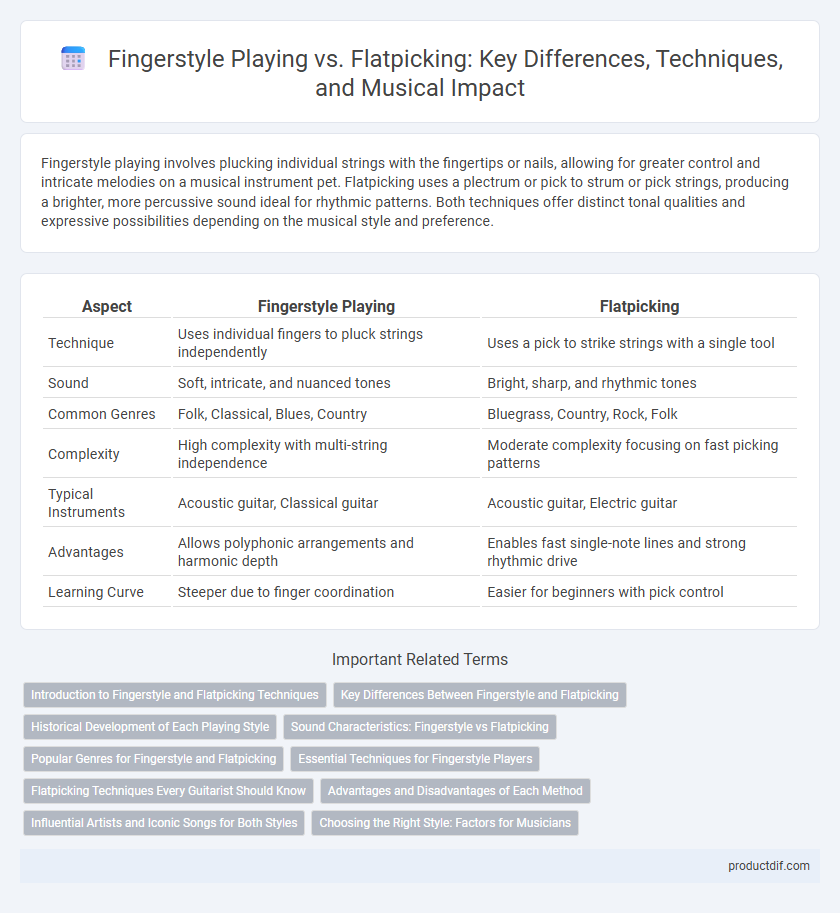Fingerstyle playing involves plucking individual strings with the fingertips or nails, allowing for greater control and intricate melodies on a musical instrument pet. Flatpicking uses a plectrum or pick to strum or pick strings, producing a brighter, more percussive sound ideal for rhythmic patterns. Both techniques offer distinct tonal qualities and expressive possibilities depending on the musical style and preference.
Table of Comparison
| Aspect | Fingerstyle Playing | Flatpicking |
|---|---|---|
| Technique | Uses individual fingers to pluck strings independently | Uses a pick to strike strings with a single tool |
| Sound | Soft, intricate, and nuanced tones | Bright, sharp, and rhythmic tones |
| Common Genres | Folk, Classical, Blues, Country | Bluegrass, Country, Rock, Folk |
| Complexity | High complexity with multi-string independence | Moderate complexity focusing on fast picking patterns |
| Typical Instruments | Acoustic guitar, Classical guitar | Acoustic guitar, Electric guitar |
| Advantages | Allows polyphonic arrangements and harmonic depth | Enables fast single-note lines and strong rhythmic drive |
| Learning Curve | Steeper due to finger coordination | Easier for beginners with pick control |
Introduction to Fingerstyle and Flatpicking Techniques
Fingerstyle playing involves plucking the strings directly with fingertips or nails, allowing complex melodies, harmonies, and rhythms to be played simultaneously on acoustic or classical guitars. Flatpicking technique uses a pick to strike individual strings, commonly emphasizing sharp, articulate melodies and fast, rhythmic strumming patterns primarily on steel-string acoustic guitars. Mastering fingerstyle enhances polyphonic texture and finger independence, whereas flatpicking emphasizes precision and speed in single-note runs and rhythmic drive.
Key Differences Between Fingerstyle and Flatpicking
Fingerstyle playing involves plucking strings individually with fingers, allowing for intricate patterns and simultaneous bass, melody, and harmony lines. Flatpicking uses a pick to strike strings, emphasizing strong, rhythmic strumming and single-note leads ideal for bluegrass and folk genres. Fingerstyle offers greater tonal complexity and dynamic control, while flatpicking delivers speed and precision in melodic passages.
Historical Development of Each Playing Style
Fingerstyle playing originated in early folk and blues traditions, evolving through pioneers like Mississippi John Hurt and Merle Travis who emphasized intricate fingerpicking patterns. Flatpicking emerged prominently in the mid-20th century bluegrass scene, popularized by guitarists such as Doc Watson, focusing on brisk, melodic single-note lines played with a plectrum. Both styles reflect distinct cultural influences, with fingerstyle rooted in diverse acoustic genres and flatpicking shaped by fast-paced string band music.
Sound Characteristics: Fingerstyle vs Flatpicking
Fingerstyle playing produces a warm, intricate sound with clear articulation of individual strings, allowing for complex harmonies and dynamic expression. Flatpicking generates a brighter, more aggressive tone with a consistent attack, ideal for driving rhythmic patterns and melodic leads. The nuanced tonal differences between fingerstyle and flatpicking significantly influence musical styles ranging from folk to bluegrass.
Popular Genres for Fingerstyle and Flatpicking
Fingerstyle playing is popular in genres such as folk, classical, and contemporary acoustic music, where intricate melodic and harmonic patterns are essential. Flatpicking is commonly associated with bluegrass, country, and traditional Americana, emphasizing fast, rhythmic strumming and single-note runs. Both techniques offer distinct tonal qualities that suit their respective genre's stylistic requirements.
Essential Techniques for Fingerstyle Players
Mastering thumb independence and fingerpicking patterns is essential for fingerstyle players to achieve a rich, polyphonic sound. Developing precise control over plucking dynamics and synchronizing thumb and fingers enables complex rhythmic and melodic interplay. Incorporating techniques such as arpeggios, hammer-ons, pull-offs, and harmonics enhances the texture and expressiveness unique to fingerstyle guitar performance.
Flatpicking Techniques Every Guitarist Should Know
Flatpicking techniques every guitarist should know include alternate picking, sweep picking, and string skipping, which enhance precision and speed across the fretboard. Mastering these techniques allows players to execute complex melodies, intricate runs, and dynamic rhythms essential for bluegrass, country, and folk styles. Consistent practice of flatpicking improves timing, articulation, and overall tonal clarity, making it a crucial skill for versatile guitarists.
Advantages and Disadvantages of Each Method
Fingerstyle playing offers enhanced tonal variety and the ability to play multiple melodic lines simultaneously, making it ideal for complex arrangements, but it requires significant finger independence and can be slower to develop mastery. Flatpicking facilitates fast, rhythmic strumming and precise single-note runs perfect for bluegrass and country genres, though it limits polyphonic textures and dynamic control compared to fingerstyle. Each method caters to distinct musical preferences and technical demands, shaping a guitarist's expressive range and stylistic versatility.
Influential Artists and Iconic Songs for Both Styles
Fingerstyle playing is exemplified by influential artists like Chet Atkins and Tommy Emmanuel, known for iconic songs such as "Mr. Sandman" and "Classical Gas," where intricate finger patterns create rich, textured sounds. Flatpicking is defined by legends like Doc Watson and Tony Rice, whose performances of tracks like "Black Mountain Rag" and "Rattlesnake" showcase fast, precise pick strokes emphasizing melodic clarity. Both styles have shaped acoustic guitar music through their distinctive techniques and seminal recordings that continue to inspire musicians worldwide.
Choosing the Right Style: Factors for Musicians
Choosing between fingerstyle playing and flatpicking depends on a musician's desired sound, technique, and genre preference. Fingerstyle offers intricate, polyphonic textures suited for folk, classical, and blues, emphasizing individual string control and dynamics. Flatpicking delivers rhythmic drive and melodic clarity ideal for bluegrass, country, and rock, focusing on pick precision and speed.
Fingerstyle playing vs Flatpicking Infographic

 productdif.com
productdif.com